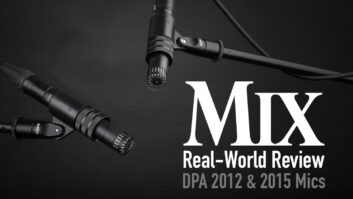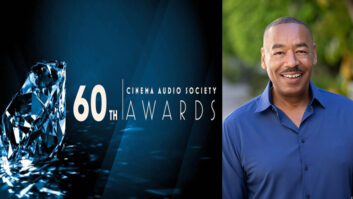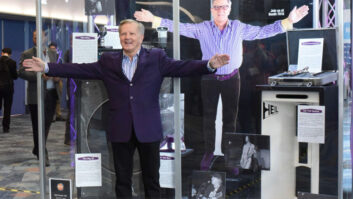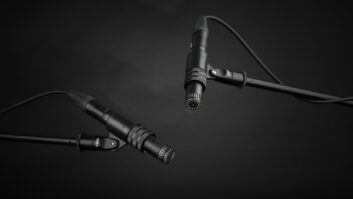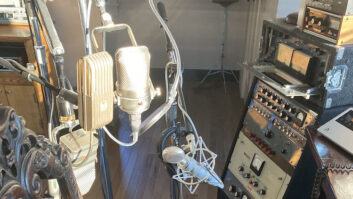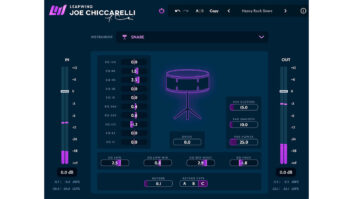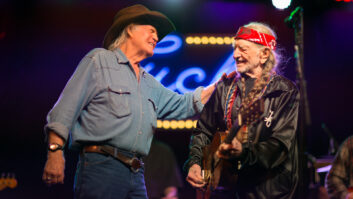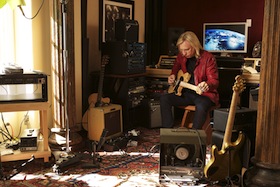
Joe Walsh
Joe Walsh is finally coming around, but it’s been a long time coming. “The last album I made, we had recording tape and knobs,” the veteran rocker laughs. “This album, we had a hard drive and a mouse. I don’t know what happened! What happened while I was gone?”
With the release of Analog Man (Fantasy) in early June—his first album in 20 years—Walsh has indeed joined the ranks of his fellow modern recording artists . . . and learned to use Pro Tools. “Joe is definitely an ‘analog man,’” says his engineer, Bruce Sugar. “So he had to learn a whole new way to record.”
Walsh has fiddled around in a hodgepodge of personal studios over the years, including a converted room in his Studio City home, followed by a slightly more professional space when he moved into a new home in Benedict Canyon three years ago. He had been actively touring with The Eagles for years at that point, and found himself with a collection of bits and pieces of songs, but with no motivation to do anything with them. “When I’d come home from an Eagles tour, the last thing I’d want to do was play guitar,” he says. “I had some songs that were half-done, but I never really got any momentum going because I didn’t exactly know how, with no more record labels around.”

Bruce Sugar and Joe Walsh
Photo by Ringo Starr
He played the songs he had for his wife, Marjorie, who urged him to complete them. “She said, ‘I really believe in you, and this stuff’s good. You ought to get up off your butt and think about finishing them. And by the way, here’s Jeff Lynne’s number.’ She’s a closer. So I listened to what was out there and tried to figure out whether I fit in anymore—should I pay attention to what people were listening to or reinvent myself. Eventually, I just figured, ‘Nah—I don’t hear anything like what I do out there. I’ll just do a Joe Walsh album. I know how to do that.’”
While he held off on calling Lynne, Walsh did put in a call to Sugar, Ringo Starr’s engineer, who began showing him the ins and outs of Pro Tools. At Sugar’s urging, Walsh had engaged the help of studio consultant Zack Fagan of Under the Wire, who set him up with a Pro Tools 7 rig (which was upgraded to versions 8 and 9 over the three-year production period) and a Digidesign D24 control surface at his old studio. Walsh put the board together himself, including wiring his own patchbays. “Joe’s very hands on; he can build just about anything,” Sugar notes. “He builds his own ham radios and his own guitars.” Jeff Lynne adds, “Joe is crazy about old radios and amplifiers. I have to say, he is very knowledgeable about them all. He even knows the color codes of resistors!”
Despite a touring schedule that kept him on the move, Walsh was able to start giving his songs some shape. “Bruce would come over and get me set up,” Walsh says. “We’d get a basic groove, with a drum machine or some samples [many of which Walsh would program himself], then he’d set me up and go home and, over two days, I could record some basic tracks. We’d pick the best stuff from several passes; that’s why it sounds like a musician playing along rather than overdubbing.”
An invited guest artist, or Walsh himself, would add bass, and drums—played by his brother-in-law, Ringo—were recorded at the old house. About a year into the tracking process, the Walsh’s Benedict Canyon home was ready, as was its studio, allowing Walsh and Sugar to continue overdubbing in the new room, using an identical Pro Tools setup and miking whatever amp Walsh was using in a simple way, using a Shure SM57 or a Neumann U 87, and passing the signal through a Tube-Tech MEC-1A mic pre.
“When I decided to record again, I went back and listened to a lot of the old stuff I did,” Walsh recalls. “What I used to do a lot was record the rhythm guitar with an acoustic guitar, and then double or triple it. Because when you hear it on the track, it’s there, but it’s not present, like an electric guitar would be. You hear it as a percussive instrument. You hear it differently; it’s transparent, but it’s there. You don’t make the track busy that way, and there’s still a lot of room for other guitars. That’s the secret to good layering of guitars.”

(L to R) Mastering engineer Howie Weinberg, producer Jeff Lynne, engineer Steve Jay, Joe Walsh
Photo courtesy Howie Weinberg
On one track, “Lucky That Way,” the guitar bed includes both 6-string and 12-string acoustics, as well as an electric 12-string made for Walsh by luthier Roger Giffin. “I put an acoustic, and then did another one, but behind the first in volume, so it’s shadowed,” Walsh explains. For the song’s rousing solo, the artist recorded as many as 15 tracks of guitars. “I could have done it all with one guitar, but I wanted to layer those in. So I took the lead part and dissected it into different phrases played on different guitars, and then pieced them together in Pro Tools. Then you put those at different places in the stereo mix, and it opens the track way up.” Sugar adds, “He has some lines doubled and some harmonies, too. That’s a really good example of how Joe made use of Pro Tools’ capabilities.”
Calling Mr. Lynne
For some songs, Walsh felt he just wasn’t able to create the kind of recording he was looking for, so he followed his wife’s advice and contacted Jeff Lynne. “I met Jeff socially and, at one point, he said, ‘Why don’t you bring your tracks over, and we’ll have a listen?’ So I did. And he had some comments and a few ideas and suggestions. Jeff just has this knack for seeing the finished track in whatever you play him. You can bring stuff that’s half done, and he sees how it would be when it’s done and helps you get there.”
Lynne notes, “Sometimes Joe would come in with a really good riff and some chords, and we’d both plug directly into the desk and jam with it and flesh it out a bit. On other occasions, he’d have the song already in demo form, and we’d make the recording using that structure.” Lynne, working with recording engineer Steve Jay, typically contributed drum tracks for the tunes, as well as guitars and keyboards.
Of the album’s title track, Lynne says, “He came in with a very rough demo, but I recognized something special in it. We played around with the arrangement a lot, until it locked in and felt right. I also wanted to feature Joe’s slide guitar playing more, so we extended the solo section. I love this solo by Joe.”
Sugar mixed his and Walsh’s tracks at the Benedict Canyon studio, occasionally working on some tunes at his own home studio, which features an identical monitor setup to Walsh’s: JBL LSR4328Ps and Genelec 8030As. Sugar also counted on Tube-Tech’s SMC-2BM stereo multiband compressor for post-mix adjustments. “It just adds a final stage of compression and equalization on the back end of the mix, after your stereo bus, and warms it up again. It’s one of my favorite things to mix through because you can really dial it in.”
Howie Weinberg at Howie Weinberg Mastering mastered the album, with both producers and engineers present. “It was great having all of them there because you get immediate feedback,” Weinberg says. “There’s no gray area, if something I’m doing doesn’t work for one of them and needs adjustment. I like working that way. And Joe doesn’t like things that are overly bright or overly bass, with a lot of sub-bottom. That’s the sign of a guy who comes from the analog era, 100 percent. And I’m from that era, too.”

Joe Walsh (with recording engineer Bruce Sugar (left) and disc cutter Chris Bellman) proudly displays a lacquer for the vinyl edition of “Analog Man” at Bernie Grundman Mastering.
Photo courtesy Bruce Sugar
Chris Bellman at Bernie Grundman Mastering cut the album for vinyl release, as well as for a promotional-only cassette. “I’d make 8-tracks if I could,” Walsh says. “That cassette sounds great in my car.”
Walsh intends to continue his move into the digital age as he builds a new, formal studio at his house, again with the help of Fagan. The new facility will be 2,300 square feet, with a 400-square-foot Tech Room, and will feature an SSL AWS 924. “The faders on the board control the Pro Tools faders but, with the push of a button, the faders control the analog signal path of the console,” Fagan describes. “It’s working just like a regular analog 24-input, 8-bus console would function. And for an analog artist like Joe, this made more sense than keeping his C24. We’re building him a professional studio; it just happens to be at his house.”
Walsh clearly enjoyed his first Pro Tools experience, while remaining cautious of the pitfalls of digital recording. “It’s too tempting to fix what doesn’t need fixing,” he says. “It’s tempting to make it perfect. If we’d had Pro Tools when The Eagles were doing Hotel California, we’d still be working on it. And you can lose that human feel. It’s not like the old days, when you’d get the whole band in there together and press Record. It’s all virtual.” Or, as he says in the song “Analog Man,” “The whole world’s living in a digital dream/it’s not really there, it’s all on the screen.”
“I’m not saying analog is better,” he concludes. “I’m just asking, ‘Now what do we do?’ People ask me what’s my advice to young musicians? I don’t know. I’m trying to figure it out, too.”
The Talk Box
What Joe Walsh record would be complete without the Talk Box—Walsh’s (and later, Peter Frampton’s) signature effects device, heard on “Rocky Mountain Way” and other classic recordings? Analog Man’s “Spanish Dancer” features the box, whose history and operation Walsh revealed to Mix.
The James Gang, of which Walsh was a key member prior to starting his solo career in the early 1970s, were all great fans of country singer Dottie West and her husband, pedal steel guitarist Bill West. “Bill invented two things: the first fuzz tone and the Talk Box,” Walsh explains. West created the device for fellow pedal steel player Pete Drake in 1953, for a recording called “Forever.” “After that song, it went into Bill West’s garage.”
Whenever The James Gang would play Nashville, after the show, they would visit the Wests. “They would invite a bunch of pickers over, and after a James Gang show, we would sit around the living room and pass the guitar around. All kinds of people would come—Glen Campbell, Ray Stevens, anybody was liable to show up.” On one such visit in 1971, he recalls, “Bill said, ‘Wait a minute—I got something for you.’ And he went out and dug around in the garage and got this old dusty, horrible-smelling thing and gave it to me. He said, ‘This goes in your mouth, and plug this in . . . you’ll figure it out. You need this.’ He gave me the original one.”
Bob Heil of Heil Sound is largely credited with taking the “talking guitar” and turning it into a popular device called the Talk Box. It’s his version that is heard on “Rocky Mountain Way.” The box, as Walsh explains, contains a speaker driver, which is connected to the output of the player’s guitar amplifier. Without a speaker cone present, the sound produced by the driver, playing the guitar amp output, is much like that of an electrolarynx, the buzzing device used by throat cancer patients who have lost their larynx. “By itself, it’s unlistenable,” he says.
The driver is housed in an airtight box with a funnel attached to the front of it, to which is connected a piece of surgical tubing. The other end of the tubing is set adjacent to a microphone near the player’s mouth. The player places the tube in his mouth and, says Walsh, “You move your mouth and hold your breath, like you’re talking. And the guitar sound from your amp, then, gets modulated in your mouth, and that’s picked up by your vocal mic. So it’s your guitar talking.”

